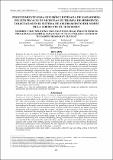Por favor, use este identificador para citar o enlazar este ítem:
https://hdl.handle.net/20.500.12958/4767Registro completo de metadatos
| Campo DC | Valor | Lengua/Idioma |
|---|---|---|
| dc.contributor.author | Mendoza, Ursula | - |
| dc.contributor.author | Ayón Dejo, Patricia | - |
| dc.contributor.author | Leigh, Bobby | - |
| dc.contributor.author | Oyola, Wendy | - |
| dc.contributor.author | Bach, Lennart | - |
| dc.contributor.author | Caquineau, Sandrine | - |
| dc.contributor.author | Bouloubassi, Ioanna | - |
| dc.contributor.author | Velazco, Federico | - |
| dc.contributor.author | Turcq, Bruno | - |
| dc.contributor.author | Sifeddine, Abdel | - |
| dc.contributor.author | Chang, Flor | - |
| dc.contributor.author | Quesquén, Roberto | - |
| dc.contributor.author | Graco, Michelle | - |
| dc.date.accessioned | 2022-07-11T21:48:00Z | - |
| dc.date.available | 2022-07-11T21:48:00Z | - |
| dc.date.issued | 2022-06 | - |
| dc.identifier.citation | Mendoza, U., Ayón, P., Leigh, B., Oyola, W., Bach, L., Caquineau S., Bouloubassi, I., Velazco, F., Turck, B., Sifeddine, A., Chang, F., Quesquén, R., Graco, M. (2022). Procedimientos para división y retirada de nadadorespellets fecales de muestras de trampa de sedimento colectadas en el sistema de afloramiento del norte de la Corriente de Humboldt. Inf Inst Mar Perú. 49(2): 315-322. | es_ES |
| dc.identifier.issn | 0378-7702 | - |
| dc.identifier.uri | https://hdl.handle.net/20.500.12958/4767 | - |
| dc.description.abstract | Este trabajo proporciona un procedimiento desarrollado y aplicado durante el proyecto KOSMOS‐Perú 2017 para evaluar el flujo y el material biológico (nadadores, pellets fecales) capturado, utilizando una trampa de sedimento automática fija, colocada en la columna de agua somera de un área del sistema de afloramiento del norte de la Corriente de Humboldt. La trampa de sedimento fue desplegada durante el periodo de verano austral, caracterizado por presentar la mayor productividad biológica y en particular, bajo las condiciones extremas del evento El Niño Costero 2017. Esta condición determinó la colecta de material de origen terrígeno en mayor proporción que durante un año no Niño. Además, el material capturado presentó alta heterogeneidad, lo cual dificultó el submuestreo representativo de la muestra bulk. Esto determinó la necesidad de desarrollar un procedimiento adecuado para manipular la muestra de la trampa de sedimento con respecto a los métodos de división, tamizado, remoción de los nadadores y los pellets fecales. Por otra parte, los errores relacionados a la precisión fueron documentados. Para ello, los esfuerzos para corregir el sesgo potencial o minimizar el problema usando esta tecnología son presentados. | es_ES |
| dc.description.abstract | ABSTRACT: This work provides a procedure developed and applied during the KOSMOS‐Peru 2017 project to assess the flux and biological material (zooplankton, faecal pellets) caught using an automatic fixed sediment trap deployed at the upper ocean of a coastal area of the upwelling system of the North Humboldt Current. The sediment trap was deployed during the austral summer period, characterized by the highest biological productivity and in particular under the extreme conditions of the coastal El Niño event 2017. This condition determined the sampling of material with terrigenous origin in a higher proportion than during a non‐Niño year. In addition, the caught material presented a large heterogeneity, which difficult the representative sub‐sampling from the bulk sample. In this particular scenario, a suitable procedure how to sample the sediment trap with respect to the splitting, sieving, swimmers and faecal pellets removal methods was described. This determined the need to develop a suitable procedure for handling the sediment trap samples with respect to the splitting, sieving, swimmers and faecal pellets removing methods. Furthermore, the accuracy‐related issues were documented. For this approach the effort to correct for the potential bias or minimize the problem using this technology is presented. | - |
| dc.language | spa | spa |
| dc.language.iso | spa | es_ES |
| dc.publisher | Instituto del Mar del Perú | es_ES |
| dc.relation.ispartofseries | Informe IMARPE 49(2), 2022; | - |
| dc.rights | info:eu-repo/semantics/openAccess | es_ES |
| dc.rights.uri | https://creativecommons.org/licenses/by/4.0/ | es_ES |
| dc.source | Instituto del Mar del Perú - IMARPE | es_ES |
| dc.source.uri | Repositorio Digital IMARPE | es_ES |
| dc.subject | Tasa de sedimentación | es_ES |
| dc.subject | Pellets fecales | es_ES |
| dc.subject | Zooplancton | es_ES |
| dc.subject | Trampa de sedimento | es_ES |
| dc.subject | Sistema de afloramiento del norte de la Corriente de Humboldt | es_ES |
| dc.title | Procedimientos para división y retirada de nadadores-pellets fecales de muestras de trampa de sedimento colectadas en el sistema de afloramiento del norte de la Corriente de Humboldt | es_ES |
| dc.title.alternative | Sediment trap splitting and swimmers-fecal pellets picking procedure of simples collected in the upwelling system of the north Humboldt Current | es_ES |
| dc.type | info:eu-repo/semantics/article | es_ES |
| dc.publisher.country | Perú - Callao | es_ES |
| dc.subject.ocde | http://purl.org/pe-repo/ocde/ford#1.06.12 | es_ES |
| Aparece en las colecciones: | Informe vol. 49(2) 2022 | |
Ficheros en este ítem:
| Fichero | Descripción | Tamaño | Formato | |
|---|---|---|---|---|
| Informe 49-2 artículo13.pdf | 489,54 kB | Adobe PDF |  Visualizar/Abrir |
Este ítem está sujeto a una licencia Creative Commons Licencia Creative Commons

